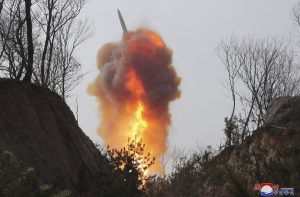Cheryl Rofer
 Even in today’s unsettled environment, the prospects for additional states to develop nuclear weapons are low. But if there is a next nuclear power, it’ll be found in Asia.
Even in today’s unsettled environment, the prospects for additional states to develop nuclear weapons are low. But if there is a next nuclear power, it’ll be found in Asia.This photo provided by the North Korean government shows what it says is a ballistic missile in North Pyongan Province, North Korea, on March 19, 2023. North Korea says its ballistic missile launch simulated a nuclear attack against South Korea. The content of this image is as provided and cannot be independently verified.Credit: Korean Central News Agency/Korea News Service via AP
It may not happen for some time, or at all, but the next nation that joins the nuclear club will be in Asia.
South America and the Caribbean are nuclear-free under the Treaty of Tlatelolco. Likewise, African countries have foresworn nuclear weapons under the Treaty of Pelindaba. The Treaty of Rarotonga covers Australia, New Zealand, and the Pacific islands, and the Antarctic is covered by a treaty too. Europe is united by Russia’s imperial war against Ukraine and sits under the protection of NATO’s nuclear umbrella.
More broadly, most nations around the world have promised, under the Nuclear Nonproliferation Treaty (NPT), not to develop or acquire nuclear weapons. Most of those outside the NPT are in Asia. Three of the Asian states outside the NPT are already nuclear powers: India and Pakistan, and North Korea, which withdrew from the NPT in 2003.
Several states in Asia have motives to proliferate, inspired by complex regional conflict dynamics and domestic ambitions alike. North Korea tests missiles. China builds up its nuclear arsenal and patrols the South China Sea aggressively. India, Pakistan, and China contest borders. Iran ratchets up its uranium enrichment. The mix of nuclear and non-nuclear nations and the complexity of the conflicts in Asia can make nuclear weapons look attractive.
On the other hand, Asia has nuclear weapon free zones too. The Treaty of Bangkok covers Southeast Asia, and Central Asia has its own treaty against nuclear weapons.
Nuclear weapons were developed with 1940s computational and engineering capabilities. Any industrial nation is capable of building them, but an industrial-scale operation is necessary. A nuclear weapons program is expensive and requires significant development and redirection of resources. Not only must the weapons themselves be developed, but delivery systems need to be created too.
A state that wants to develop nuclear weapons would have to withdraw from the NPT, a move that would trigger considerable consequences. Alliances with other states would weaken or be broken, with, for example, sanctions or travel bans imposed. Tensions with adversary states would increase. And ultimately, nuclear weapons cannot prevent conventional conflict, as seen in the Sino-Soviet border war of 1969 and the 1999 Kargil War between India and Pakistan.
The world’s largest nuclear powers – the United States, Russia, and China – have an outsized influence on proliferation potential in Asia. Their activities may lead other nations to consider developing their own nuclear weapons.
No comments:
Post a Comment